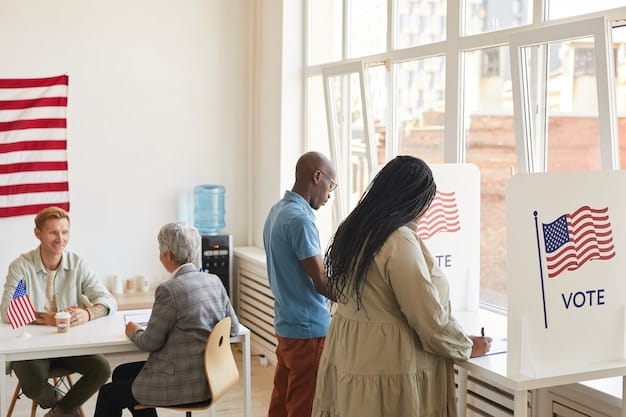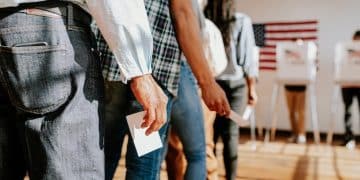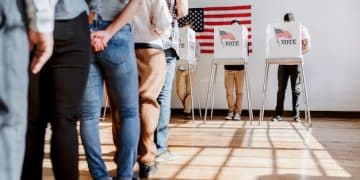Understanding Voter ID Laws Impact on Minority Turnout in 2024 Election

Understanding the Impact of Voter ID Laws on Minority Voter Turnout in the 2024 Election is critical to assessing the fairness and accessibility of the electoral process, as these laws have raised concerns about potentially disproportionate effects on minority communities.
The debate around voter ID laws has intensified in recent years, especially concerning their potential impact on minority voter turnout. Understanding the Impact of Voter ID Laws on Minority Voter Turnout in the 2024 Election requires a careful examination of historical data, legal challenges, and socio-political factors.
Voter ID Laws: An Overview
Voter ID laws require voters to present identification at the polls before casting their ballots. These laws vary significantly by state, ranging from strict photo ID requirements to acceptance of non-photo identification. Understanding these variations is the first step in understanding the impact of voter ID laws on minority voter turnout in the 2024 election.
Types of Voter ID Laws
States implement different types of voter ID laws that can broadly be categorized into:
- Strict photo ID laws: Voters are required to present a valid photo ID, such as a driver’s license or passport.
- Non-strict photo ID laws: Voters without a photo ID can still vote by signing an affidavit or using a provisional ballot.
- Photo ID requested, but not required: Voters are asked to present a photo ID, but alternative forms of identification can be used.
Arguments for Voter ID Laws
Proponents of voter ID laws argue that they are necessary to prevent voter fraud and maintain the integrity of elections. Concerns about impersonation fraud at the polls are often cited as justification for these laws.
However, a comprehensive analysis of election data reveals that incidents of in-person voter impersonation are exceedingly rare. Critics argue that emphasis on this rationale is often politically motivated, rather than based on demonstrable evidence.

In conclusion, voter ID laws come in different forms, and understanding the premise behind them is critical to comprehending their genuine effects. Even nonetheless, there is disagreement about whether they really protect the integrity of elections or if they simply constitute a barrier to the right to vote.
Historical Context of Voter Suppression
The history of voter ID laws is intertwined with a legacy of voter suppression, particularly targeting minority communities. To fully appreciate the implications of these laws, it’s essential to understand their historical context.
Jim Crow Era Tactics
Following the Civil War, Southern states enacted various measures to disenfranchise Black voters. These tactics included:
- Poll taxes: Required voters to pay a fee, which disproportionately affected low-income individuals.
- Literacy tests: Required voters to demonstrate reading ability, often administered unfairly to Black voters.
- Grandfather clauses: Exempted individuals whose ancestors had voted before the Civil War, effectively excluding Black voters whose ancestors were enslaved.
The Voting Rights Act of 1965
The Voting Rights Act of 1965 (VRA) was a landmark piece of legislation that aimed to eliminate discriminatory voting practices. It authorized federal oversight of elections in states with a history of discrimination.
Section 5 of the VRA required certain states and jurisdictions with a history of voter suppression to obtain preclearance from the Department of Justice before making changes to their election laws. This provision was crucial in preventing the implementation of new discriminatory measures.

The 2013 Supreme Court decision in Shelby County v. Holder struck down Section 4(b) of the VRA, which determined the jurisdictions covered by Section 5. This decision removed the preclearance requirement, leading several states to enact restrictive voting laws, including stricter voter ID laws.
Impact on Minority Voter Turnout
The primary question is how voter identification laws influence diversity in voter turnout. Different studies have shown that voter ID laws have a disproportionate impact on minority groups. This section focuses on the evidence surrounding the impact of these laws.
Studies and Research Findings
Numerous studies have examined the impact of voter ID laws on turnout. Some key findings include:
- Reduced turnout: Studies have shown that strict voter ID laws can reduce voter turnout among minority groups, particularly African Americans and Latinos.
- Disproportionate impact: The impact is disproportionate because minority voters are less likely to possess the forms of identification required by these laws.
- Practical difficulties: Obtaining required identification can pose practical difficulties, especially for low-income individuals, the elderly, and those living in rural areas.
Reasons for Disparate Impact
Several factors contribute to the disproportionate impact of voter ID laws on minority voters:
Limited access to identification: Minority voters are less likely to have driver’s licenses or other forms of photo identification due to socioeconomic factors, such as limited access to transportation or financial constraints.
Awareness and knowledge: Lack of awareness about voter ID requirements and how to obtain necessary identification can also be a barrier for some minority voters.
Transportation barriers: Limited access to transportation can make it difficult for individuals to travel to government offices to obtain required identification.
These factors collectively create barriers that can significantly reduce minority voter turnout, undermining principles of equal access to the ballot box.
Legal Challenges to Voter ID Laws
Voter ID laws have faced numerous legal challenges, often alleging violations of the 14th and 15th Amendments. These challenges underscore the ongoing debate about the constitutionality and fairness of such laws.
Fourteenth Amendment
The Fourteenth Amendment guarantees equal protection under the law. Opponents of voter ID laws argue that these laws violate the Equal Protection Clause by disproportionately burdening minority voters. They contend that the laws create barriers to voting that do not apply equally to all citizens.
Fifteenth Amendment
The Fifteenth Amendment prohibits denying or abridging the right to vote based on race. Legal challenges based on this amendment argue that voter ID laws have a discriminatory effect, even if they are not explicitly discriminatory on their face.
Key Court Cases
Several key court cases have addressed the legality of voter ID laws. Some notable examples include:
- Shelby County v. Holder (2013): As noted earlier, this Supreme Court decision struck down a key provision of the Voting Rights Act, leading to the enactment of more restrictive voting laws.
- Frank v. Walker (2014): This case challenged Wisconsin’s voter ID law, with plaintiffs arguing that it violated the Equal Protection Clause. The law was ultimately upheld after several legal battles.
- Veasey v. Abbott (2014): This case challenged Texas’s voter ID law, arguing that it discriminated against minority voters. A federal appeals court found that the law had a discriminatory effect.
The 2024 Election Landscape
The 2024 election underscores the modern-day stakes of voter ID laws, with proposed and current legislation shaping the demographics of those most able to vote. Many people wonder how election integrity is maintained.
Current State of Voter ID Laws
As of 2024, numerous states have implemented strict voter ID laws. These laws vary in their specific requirements, but they generally require voters to present a valid photo ID at the polls. Some states also have provisions for alternative forms of identification or exceptions for certain individuals.
Potential Impact on the 2024 Election
The current state of voter ID laws could have a significant impact on minority voter turnout in the 2024 election. Factors to consider include:
Geographic distribution: States with large minority populations are more likely to be affected by strict voter ID laws.
Awareness campaigns: Efforts to inform voters about ID requirements and how to obtain necessary identification are crucial.
Legislative battles: Ongoing legislative battles over voter ID laws could further shape the election landscape.
A lot of the media coverage for the 2024 election revolves around the accessibility of safe locations to vote. The location of polling places and the availability of assistance from translators can influence the numbers of voters who turn out to the ballot box.
Strategies to Mitigate Disparate Impact
While voting rights movements continue to rise in popularity, practical workarounds can be found at the state level. Community organizations sometimes provide funding or transport for people who would not otherwise meet voter ID requirements.
Public campaigns can remind and educate voters about voting laws. By getting ahead of misinformation, officials improve the state of their local election, making it one where more people feel safe to engage.
Moving Forward: Ensuring Fair Access to the Ballot
Fair accessibility in the voting process is critical to upholding democracy. Guaranteeing that all eligible citizens can exercise their right to vote demands proactive measures. These actions need to address the issues caused by voter identification regulations, promoting inclusivity and equity in elections.
Policy Reforms
Policy Reforms are one way to address voter ID laws. States can pass laws that loosen voter ID laws. Automatic voter registration is one such example of bringing down institutional barriers.
Community Engagement
Local groups frequently start voter enrolment drives and educational initiatives. These initiatives help those communities that are traditionally marginalized. They make sure that everyone is aware of their rights and has the resources they require to successfully cast a ballot.
Legal Advocacy
Groups can challenge voter ID laws in court if they think that they may marginalize particular segments of the population. These cases make sure that the courts uphold people’s right to vote and stop discriminatory laws from being passed.
| Key Point | Brief Description |
|---|---|
| 🔑 Voter ID Laws | Require voters to present identification at the polls, varying by state. |
| 📉 Minority Turnout | Studies show reduced voter turnout among minorities due to strict ID laws. |
| ⚖️ Legal Challenges | Laws face challenges under the 14th and 15th Amendments for discrimination. |
| 🗳️ 2024 Election | Current laws may significantly impact minority voting; mitigation strategies needed. |
Frequently Asked Questions
▼
Voter ID laws require voters to present identification at the polls before casting their ballot. These laws vary by state, with some requiring photo IDs and others accepting non-photo identification.
▼
Voter ID laws are controversial because critics argue that they disproportionately affect minority voters, low-income individuals, and the elderly, who may have difficulty obtaining the required identification.
▼
Studies suggest that strict voter ID laws can reduce voter turnout among minority groups, particularly African Americans and Latinos, who are less likely to possess the necessary forms of identification.
▼
Voter ID laws have faced legal challenges under the Fourteenth and Fifteenth Amendments, with plaintiffs arguing that these laws violate equal protection and have a discriminatory effect on minority voters.
▼
To mitigate the impact of voter ID laws, states can implement automatic voter registration, expand the types of acceptable identification, and conduct public awareness campaigns to inform voters about ID requirements.
Conclusion
Understanding the Impact of Voter ID Laws on Minority Voter Turnout in the 2024 Election requires a nuanced approach, balancing concerns about election integrity with the fundamental right to vote. By addressing historical injustices, implementing policy reforms, and promoting community engagement, we can strive towards a more inclusive and equitable electoral process for all.





